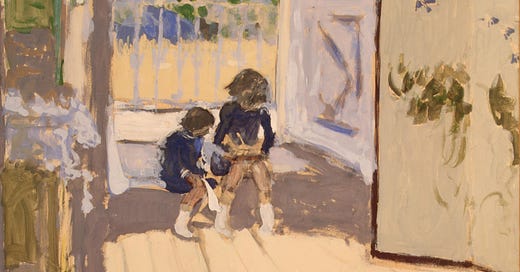“If you don’t like reading it,” said one of my husband’s greatest teachers, “throw it out.” He was speaking of children’s literature, encouraging parents that trusting their taste in books was likely better for their children as well. If the book is not enjoyable for you as an adult, it’s probably not nourishing your child either. That’s not to say children shouldn’t enjoy their literature. They absolutely must. But we nurture and encourage their growth by giving them books that resonate with us in our maturity (At least we hope we’re mature.) as well.
This has become a principle in other areas of our family life: “If you as an adult don’t like it, don't purchase it” This goes for books, clothes, furniture, baby toys, and so on. (Similar to my insistence on real materials, I sometimes make exceptions, acquiescing to my children’s requests, and usually do regret it.) For the most part, however, we keep to the principle. And the result is an interior world that our whole family feels at home in.
Allowing books, music, clothes, and interiors that are not truly beautiful and pleasing to the adult spirit syphons off a strange space in which somehow the rules of beauty are suspended and children are treated as less than their dignity.
I do not fault my children for their taste, which I will refrain from categorizing. It just is, and I trust that it will grow. Rather, I fault the industries that promote and market less than beautiful and less than quality things to children. Companies know that the shiny and graphic will appeal to them. As the child psychologist Lawrence Cohen writes, the young are a vulnerable sales demographic. He interestingly notes that we limit the potential for children's play (providing them with a script instead of letting them craft their own) when we give them pre-designed toys and activities. Think barbies, toy guns, and superhero dolls.
I am grateful for his encouragement to question the ever-overwhelming world of baby and children’s accoutrement, just like my husband and I are grateful for the permission his professor gave us to read the children’s literature we delight in.
The ever insightful, ever controversial Ivan Illich also calls attention to this fairly modern idea of childhood. He writes, “Only with the advent of industrial society did the mass production of ‘childhood’ become feasible and come within the reach of the masses.” In Illich’s account, the nineteenth century bourgeoisie “discovered” childhood.
Until then, society treated children fairly similarly to adults: “The worker’s child, the peasant’s child, and the nobleman’s child all dressed the way their fathers did, played the way their fathers did, and were hanged by the neck as were their fathers.” Although this last shared experience, that of being hanged, rightly disturbs us, it presents a striking example of the continuity between childhood and adulthood that pervaded culture. Society regarded children and adults as equals and treated them as such.
Contrarily, contemporary culture encourages a kind of special treatment for children, from schooling to toys, from manners of relating to interior spaces, although these are only accessible to certain classes, if we’re honest. (Those without the means resent the fact that they cannot give their children this “childhood,” as Illich notes.)
At first glance, Illich’s critique may cause us to bristle, but his argument is not one of neglecting children or putting them to work. He actually wants to acknowledge children’s potential for independent knowledge and skill and their desire to be treated as humans. His hope is to move beyond the segregation created by age and income.
To his point, my children rarely authentically enjoy toys and instead turn to ordinary household tools and natural materials for their play: books, bowls, sticks, leaves. It makes sense; in the midst of their wonder and imagination—skills none of us should lose—they learn from adults intuitively and intuitively want to be among us.
Children have things to learn (as do we adults), but maybe they learn better without all that mass-produced childhood has to offer.
Our conception of childhood is influenced and fueled by "the advent of industrial society,” Illich writes, suggesting that mass education has propelled our preoccupation with crafting childhood. But, I think, in light of his work Tools for Conviviality, Illich may also be considering the market economy’s contribution: it has goods to sell. Children (and their parents) are no longer able participants in society but consumers of what they are told they need.
We can learn from Illich’s observations, I think, even if we do not wholly embrace them ourselves. His end is to restore human freedom, and in this way, he shows us that we can raise thriving children without many toys, without endless special baby gadgets, without nurseries that will need redecorating in a few years. Instead, we can invite our little ones into what we find beautiful and inspiring, prioritizing order and usefulness and quality.
A final encouragement comes from John Holt, whose work centers on children and how they learn best. “What children need,” he claims, “is not new and better curricula but access to more and more of the real world.” In other words, adults may tend to overthink children and what benefits them. Let’s guide our little ones into the real, ourselves also encountering it anew.








Very well said. Children need to be able and encouraged to use their imagination too
Thoroughly enjoyed reading this, thank you !